March 2022 Network News
Village news
In this issue
Hi-tech says Hi to old-tech: 3D mud wall printing

Printed MUD wall Research project & Crowdfunding Request
University researchers will team up with natural builders in a trial of cutting-edge 3D printing techniques to build a modular wall using local earth materials.
Narara Ecovillage & Narara Ecovillage Education (NEV Ed) along with MUDTEC and Integrated Biotecture are sponsoring the university team to build the wall using advanced 3-D printing equipment and computational techniques.
The project will take place during a 3-day workshop as part of the Computer-Aided Architectural Design Research in Australia (CAADRIA) “Post Carbon” 2022 Conference in Sydney.
The aim of this workshop is to take the first step towards establishing 3D printed wall structures that could gain approval by Australian building authorities.
Such printed walls could become part of future housing projects that meet the challenges of climate change, both at Narara Ecovillage and beyond.
Workshop participants will learn about vernacular architecture in hot climates, biomimicry principles, the properties of earth materials such as clay and cob, and the use of computational techniques, a 3D Potter arm and clay extrusion system to print the modular wall.
While the university team is providing the laboratory, 3D printing equipment and expertise, and MUDTEC is providing the know-how of working with clay and cob mixtures, NEV Ed is contributing $2,000 to cover some travel, accommodation and other expenses for the Melbourne cob expert, supply and transport local Central Coast earth materials, and Ecovillage space to exhibit the finished wall for further testing and learning.
However, we need more funds to cover the cost of mixing materials to the required formula, expenses for the workshop coordinator, and transporting the wall back from Sydney to the Ecovillage.
CAADRIA is offering a limited number of free workshop spots to NEV members, so village members sponsoring $100 are eligible to apply to attend half a day. Apply by emailing caadria@nararaecovillage.com.
Our target for this crowdfunding is a further $2,000.
Are you able to chip in to bump up the Ecovillage’s sponsorship of this innovative and leading-edge project? Please donated by online deposit to the bank account below:
- Name: NARARA ECOVILLAGE CO-OPERATIVE LTD
- BSB: 633000 Account number: 165895640
- Reference: CAADRIA (plus your Surname)
- For further information, please email the workshop’s NEV team at caadria@nararaecovillage.com.

This leechy life

-Liz Bassett
Recently more than one village member has wound up in hospital with infected leech bites, so we responded by crowd-sourcing the best info we could find. And here it is for your delectation:
Prepare to deal with leeches so you can enjoy our wonderful outdoors
Summary: The MAIN problem caused by leeches is … INFECTION! So …
- Remove the leech without bothering it
- Clean & cover the wound area
- Keep the wound clean & covered
1) Remove the leech without bothering it (it may regurgitate into the wound) – HOW TO REMOVE
Gently lever it off using a hard, thin object such as a fingernail or piece of stiff plastic
Locate the head and mouth. A leech’s head is smaller and slimmer than the rest of its body. There is a sucker at the other end too- hilarious!
Use one hand to gently pull your skin under the leech until it’s taut, then use your lever to gently break the seal of the mouth sucker.
Flick! (NB leeches are very hard to squash)
You can leave the leech on till it drops off voluntarily
DO NOT – use irritants like salt, flame or insect repellent: this will just annoy the leech & possibly mess up the wound
2) Clean & cover the wound area
THOROUGHLY Clean the wound as soon as you can: tea tree oil, anti-bacterial wipes, betadine, phisohex, soap and water, hydrogen peroxide, rubbing alcohol or other first aid cleanser, eucalyptus oil
Even if your leech has safely dropped off, the wound still needs to be cleaned, as the anticoagulant prevents it from healing quickly, potentially allowing bacteria to enter
Cover with something sterile- Change the bandage frequently for the first few hours until bleeding stops. The wound may take several days to fully heal. Non-adherent dressing under 1 or more bandaids can help soak up the blood from the bite if just a band-aid does not suffice.
3) Keep the wound clean & covered- that means DON’T SCRATCH
Leeches inject an anticoagulant into your blood- this is what causes the itchiness. Don’t scratch the bite, even days later! Scratching can introduce bacteria into the slowly-healing wound. People react differently to leech bites. Some have an allergic/inflammatory response.
Recommended to reduce ITCHINESS:
Creams such as Bonjela (anaesthetic gel for teething babies), or 1% hydrocortisone cream (over the counter) daily AROUND the bite site but not ON the bite site itself (cortisone and potentially infected wound do NOT go together)
If you get an allergic reaction, Mega doses of vitamin C can help minimize the inflammatory response; oral antihistamine (prescription required?)
If the area is red, hot or swollen after 24 hours, you should see a doctor (possibly need antibiotics). If you are concerned about cellulitis, use a pen to mark the line of red and then monitor over 24 hours. If it grows quickly, do something about it quickly.
LEECH KIT for enjoying the great outdoors:
Wear
- Trousers tucked into socks, or gaiters & insect repellent
- leech socks
- Red-coloured gum boots to see them coming
- White stockings to see them coming and make it hard for them to bite
Carry something to:
- remove the leech: fingernail, sliver of plastic
- clean the wound: tea tree oil, betadine, tissues …
- cover the wound: bandaids, bandage
- insect repellent, if you like
References
- NEV members!
- https://europepmc.org/article/MED/30085513
- https://www.healthline.com/health/how-to-remove-a-leech#steps
Bamboo & Straw House & Art Studio – Building Update

-Linda Scott
It’s a big project (I was warned!) and it’s a thrill when progress, big or small, is achieved.
Currently, in the main house, the bamboo reciprocal roof has just had an added ringbeam for strength and aesthetic appeal. Work on the cupola roof will begin soon.
The art studio living roof has plantings of marigolds, geraniums, daisies, calendulas, nasturtiums and many more plants to go. I’ve got Yates seeds, everything blue and another one everything pink, which I’ll be seed bombing soon! Work is focussing on a sawdust pathway up the middle to make access easier. Later a vertical garden will wrap around the central pole.
Photos below: front door & bamboo roof
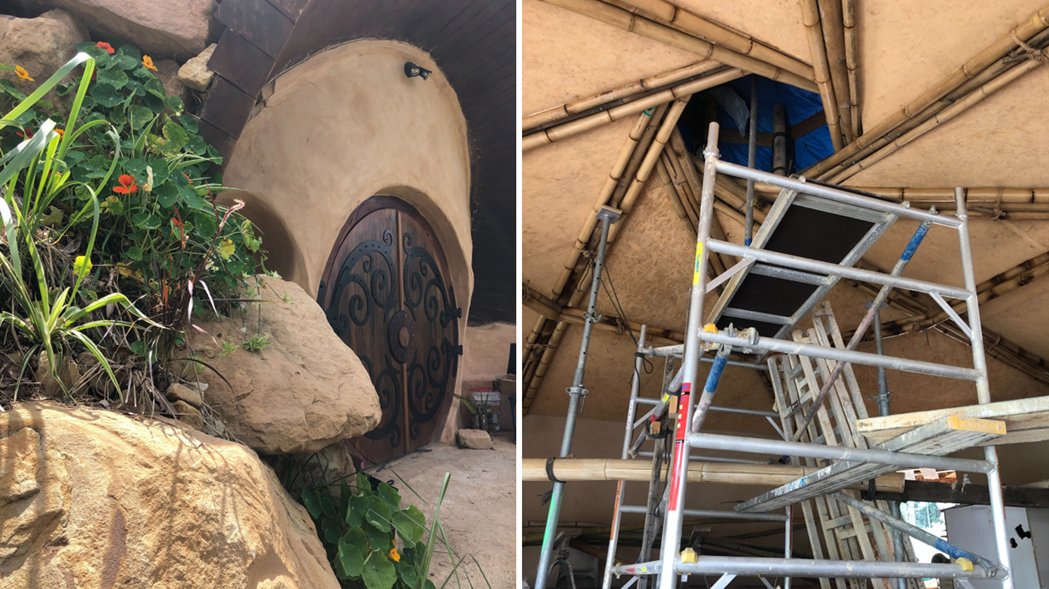
Ecovillage Experience Weekend: good times all around

-Rafaele Joudry
We held the first NEV Experience Weekend earlier this month.
After two COVID deferrals and in the midst of weeks of heavy rain and flooding across the east coast, the event finally went ahead as planned. Some guests chose the option to defer, but thirty-seven participants attended, including six children. In the end there was very little rain, and even the campers were safe in their tents!
Feedback has been enthusiastic from guests and villagers alike.
For guests, it was a chance to immerse in Ecovillage life, and experience the connection and richness of having so many like-minded people all striving together for similar outcomes.

For villagers it was a great opportunity to step out of the isolation of recent months and revive the pot-luck dinners, food growing, story-telling, workshops, and deep conversations over a coffee and cake, that are the essence of life in this type of community.
Highlights included the Deep Ecology workshop with John Seed, which delved into our feelings about the threats to our beautiful planet and what it means to be a human who cares at this time; the eco-homes tour where guests learned about the pros and cons of different building techniques; the story telling night where yarns were shared about the villagers’ adventures over the years; the circus skills workshops in the village hall, which had adults and kids playing, spinning, balancing and juggling happily for hours; the kids’ craft workshops where creative natural handicrafts abounded and decorated all the tables. Guests also loved learning about the smart grid, tool-sharpening and mushroom-growing; working in the community garden; enjoying the wood-fired mud brick pizza lunch, and joining the biodiversity and bird walks.
Due to the great response, it will all be happening again in a few months, so stay tuned for the next event!
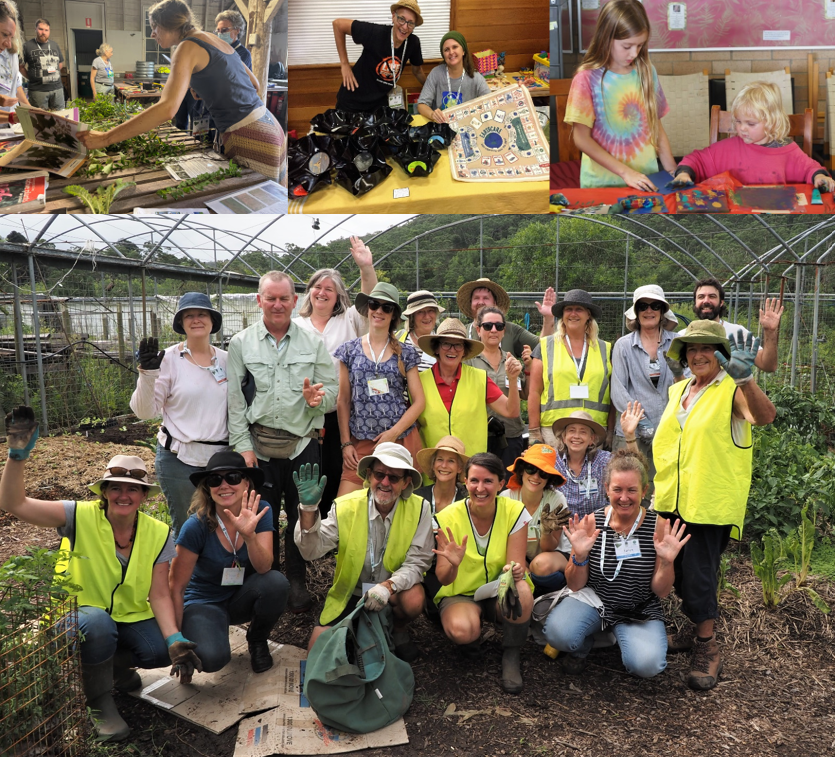
Prosocial at Narara Ecovillage
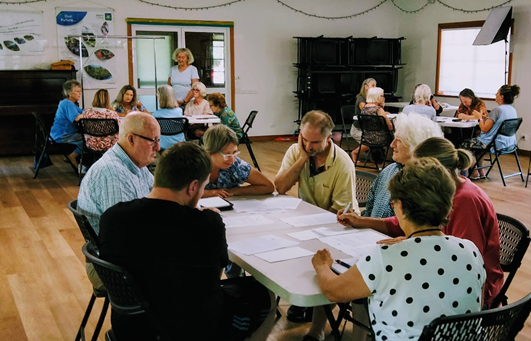
-Liz Bassett
Prosocial is a science-based framework for understanding how groups function, and it includes processes for enhancing cooperation & collaboration and helping groups to evolve over time. It is completely compatible with sociocracy, the governance system we use at Narara Ecovillage.
At this workshop, run by village member Pip Atkins, participants discussed how NEV stacks up against six of the core principles of sustainable groups at any scale:
- Shared identity and purpose
- Equitable distribution of contributions and benefits
- Fair and inclusive decision-making
- Transparency regarding agreed behaviors
- Graduated responding to helpful and unhelpful behaviour
- Fast and fair conflict resolution
Imagine a world where these common-sense principles were commonly applied!
As the village welcomes many new members into Stage 2, it’s essential to keep our eye on how, & how well, we collaborate and, in this fast-changing world, how to remain adaptable, responsive and kind.
Scorecard: we are not there yet, but aiming for top marks in all these areas.
Next workshop: tools for managing change.
Bird Stories
An inexperienced hunter
-Richard Cassels
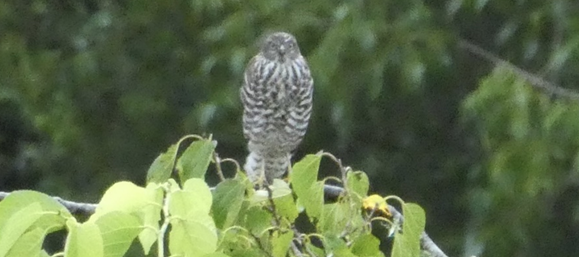
Above: a young Collared Sparrowhawk visiting the Narara Ecovillage in early February, in the rain.
Apparently a very inexperienced bird: it had a few unsuccessful attempts to catch swallows (generally only falcons can manage that!); sat on an open tree top for one hour while a Noisy Miner gave continuous alarm calls from a safe distance (needs to learn to sit unobtrusively in a tree), and did not flinch when I pointed camera and binoculars at him/her (many birds of prey will freeze when they see they are being looked at, and the the moment you take your eyes off them, even for a second, they vanish).
I hope he/she learns these lessons in time!
Sparrowhawks are the smallest and rarest of our three Accipiters, the biggest being the Grey Goshawk, then the Brown Goshawk. While the Goshawks can take prey as big as a rabbit, Sparrowhawks specialise in catching small birds in the air (but not swallows!). The equivalent Accipiter in North American is called the Sharp-shinned Hawk.
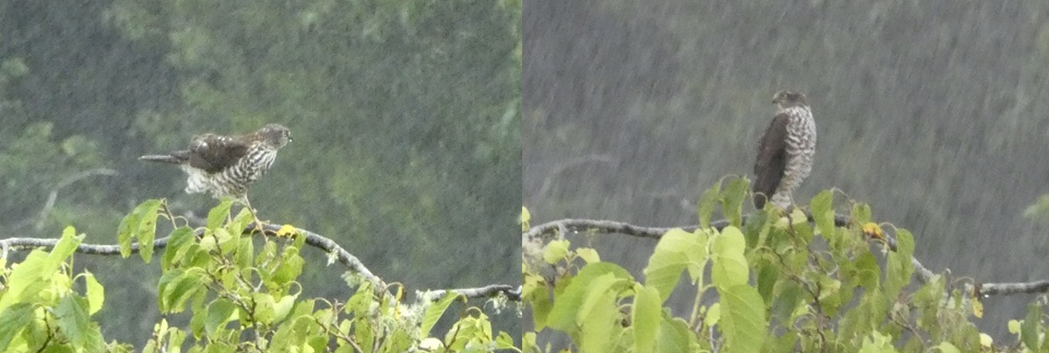
Scenes from the birdbath
-Richard Cassels
Below: Superb fairy Wrens, Red-browed Finches and a Willie Wagtail

The important thing about birdbaths is to keep them really clean, and have bushes or a tree nearby for the birds to escape into if a predator appears.
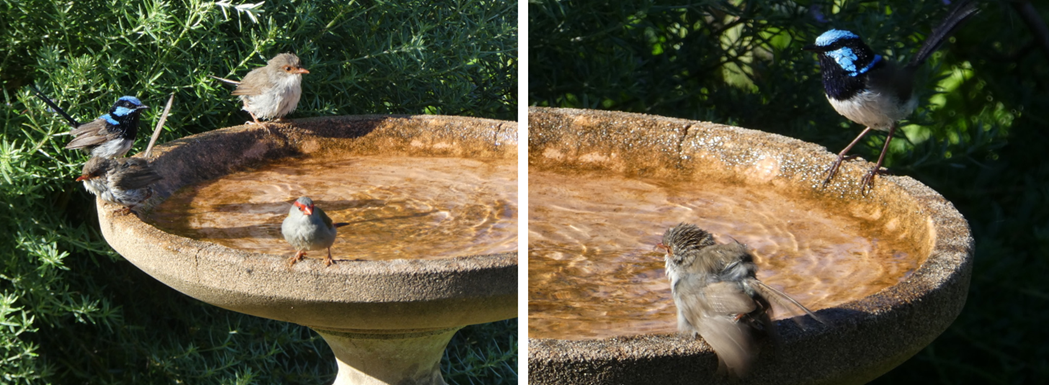
Contact the Network News
Liz Bassett Editor network.news@neln.org.au
About the Network and the Village

The Network
The Narara Eco Living Network is a not-for-profit educational and outreach body established by members of Narara Ecovillage to foster more sustainable living in all its forms and promote the vision of the village.
We publish the Network News and run networking & educational events and community projects.
Become a supporter of the Network – 12 months membership is only $20 an individual or $40 a family. Networkers are offered discounts to a variety of events at the village, and free entrance to Open Days. Click here to check out upcoming events. The network is 100% run by volunteers so we really appreciate your support!

The Ecovillage
Narara Ecovillage is a community that blends the principles of ecological & social sustainability, good health, business, and caring. We are located on the NSW Central Coast at 33 Gugandi Road, Narara 2250. Click here for more info about Narara Ecovillage
| To unsubscribe Please reply to this email, and write the word “unsubscribe” in the body of your email. |

